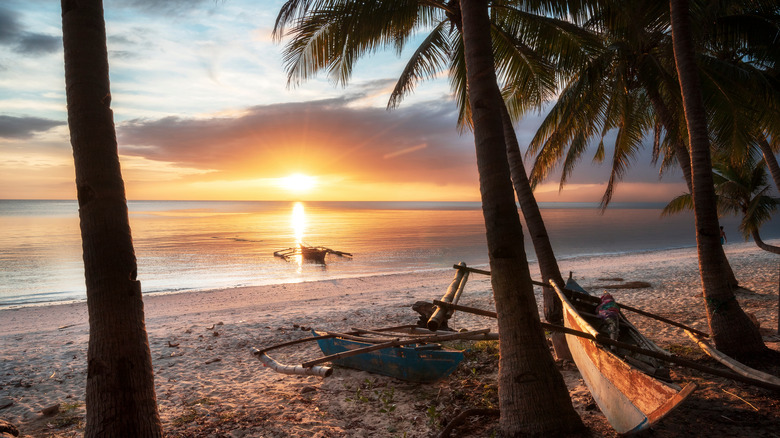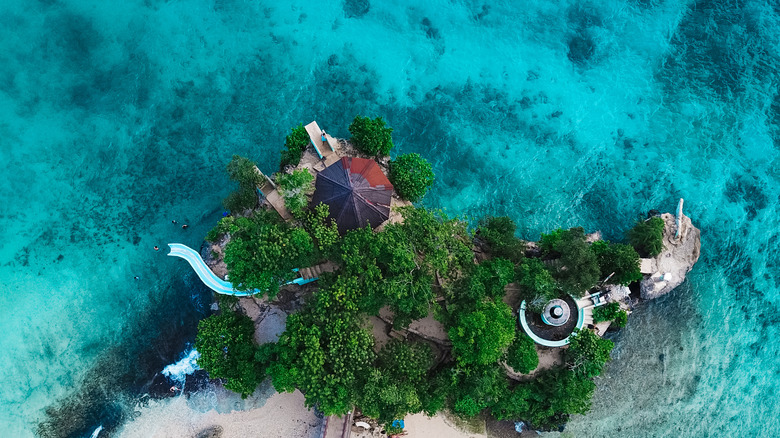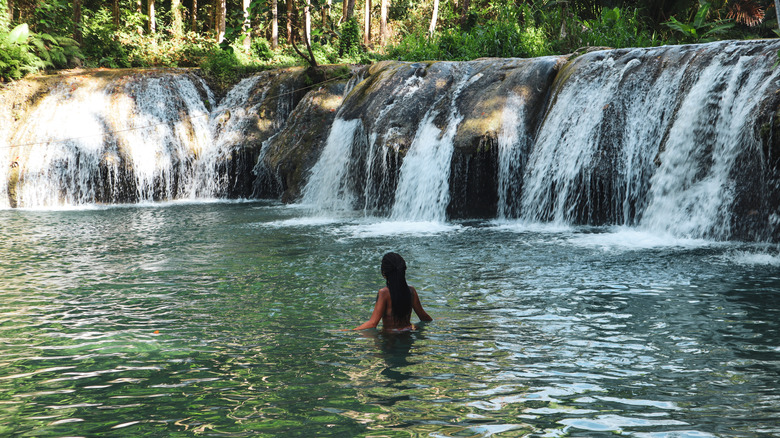The Hidden Gem Tropical Destination Known As The Philippines' Island Of Witches
If you're looking for a destination that is full of magic, mysticism, and mystery, it's time to plan a trip to the beautiful island of Siquijor. Located in the Visayan Island group of the Philippines, the remote island isn't the easiest to get to, but it absolutely rewards those who do. It is about 133 square miles in size and is surrounded by the Bohol Sea. It's known for gorgeous white sand beaches, caves, waterfalls, and witchcraft.
Siquijor has been called many names over the years, including Mystic Island and the Island of Witches. The Indigenous people once called it Katagusan and early Spanish colonists dubbed it Isla de Fuegos, or Island of Fire, likely due to the abundant fireflies that ignited the island with an otherworldly glow each evening. Siquijor is well known around the Philippines for its mysterious and magical history.
The witchcraft in Siquijor isn't something you'd expect to see in a Harry Potter movie, so leave the cliches at home and visit with an open mind. You won't find magic wands and wizard hats on Siquijor. What you will find are healers, herbalists, and mystics with practices deeply rooted in ancestral knowledge, as well as rituals that have been passed down for generations. Even if the witches can't rid you of your negative energy, the natural beauty of Siquijor Island will surely rejuvenate your spirit. One thing is certain — you're bound to be bewitched by this beautiful, hidden gem island in The Philippines.
Legend, folklore, and traditional healing on Siquijor Island
The origins of the magical and healing arts visitors can experience on Siquijor date back hundreds of years. Practices have been passed down from generation to generation. The Spanish colonizers brought Catholicism to the island during the Spanish Colonial Period, which lasted from the mid-1500s to the late 1800s. Many islanders have combined their traditional ancestral spiritual beliefs with Catholic religious practices to create their own eclectic belief system.
One of the most well-known healing techniques on Siquijor is called bolo-bolo. The unique method is believed to have originated on the island. Many illnesses on Siquijor are believed to be the result of bad spirits or curses, and the first hospital didn't open on the island until the late 1940s. Until then, traditional healing methods and herbal remedies would have been islanders' only option when they fell ill. Bolo-bolo involves placing a special stone in a cup of water. Healers will then blow into a straw made from bamboo, known as a "bagacay" and move it around the inflicted person's body to remove bad energy, spirits, and curses. Other healers rely on massage techniques called "hilot" and herbal remedies.
While most of the witches of Siquijor are healers or practitioners of "white magic" there are still rumors of islanders who practice the dark arts, using tools like human skulls to curse people. These sorcerers are called Mangkukulam, and are believed to use their spellcasting skills for both good and evil acts.
Siquijor's magical tourism
For some time, Siquijor's spooky folklore and rumors of witchcraft may have deterred some travelers over the years, but now the government is using the lure of healing arts to its advantage. The witches of Siquijor may be responsible for a tourism boom. Wellness-related travel is on the rise, especially since the COVID-19 pandemic, which caused people to grow more concerned with their physical and mental well-being. Travelers are continuing to look for new ways to look and feel their best through unique experiences.
For travelers planning a trip to experience some of the beautiful beaches in the Philippines, spending a few days in Siquijor and exploring some of the unique healing techniques may be worthwhile. The easiest way to find and book healing sessions on Siquijor is to consult your hotel. They'll be able to point you in the right direction with recommendations for local practitioners open to working with tourists. Many of the island's healers live around the Mount Bandilaan National Park and cultivate traditional medicinal plants that can assist with a variety of ailments.
The Siquijor Tourism Office also offers a healing and wellness tour, which allows visitors to experience bolo-bolo along with a traditional Balay Pahauli, or "hut of restoration" during their trip. After a morning of healing remedies, travelers can enjoy an idyllic escape surrounded by beautiful waterfalls and rivers along with a pilgrimage hike to the Holy Mountain of God. Consider the most budget-friendly time to visit the Philippines to make the most of your trip.


